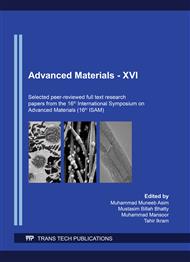[1]
Holden, G., Thermoplastic elastomers, in Rubber technology. 1987, Springer. pp.465-481.
Google Scholar
[2]
Usuki, A., A. Tukigase, and M.-j. Kato, Preparation and properties of EPDM–clay hybrids. Polym. 2002. 43(8): pp.2185-2189.
DOI: 10.1016/s0032-3861(02)00013-7
Google Scholar
[3]
Varkey, J.T., S. Augustine, and S. Thomas, Thermal degradation of natural rubber/styrene butadiene rubber latex blends by thermogravimetric method. Polym.-Plast. Technol. Eng. 39 (2000) 415-435.
DOI: 10.1081/ppt-100100038
Google Scholar
[4]
Nair, T.M., et al., Dynamic mechanical analysis of ethylene–propylene–diene monomer rubber and styrene–butadiene rubber blends. J. Appl. Plom. Sci. 112 (2009) 72-81.
DOI: 10.1002/app.29367
Google Scholar
[5]
Fröhlich, J., W. Niedermeier, and H.-D. Luginsland, The effect of filler–filler and filler–elastomer interaction on rubber reinforcement. Comp. Part A: Appl. Sci. Manuf. 36 (2005) 449-460.
DOI: 10.1016/j.compositesa.2004.10.004
Google Scholar
[6]
Alipour, A., et al., Elastomer nanocomposites based on NR/EPDM/organoclay: morphology and properties. Intern. Polym. Proc, 26 (2011) 48-55.
DOI: 10.3139/217.2381
Google Scholar
[7]
El-Nashar, D., The compatibilization of EPDM/SBR blends by EPDM-graft-styrene copolymer. Polym.-Plast. Technol. Eng. 43 (2005) 1425-1441.
DOI: 10.1081/ppt-200030213
Google Scholar
[8]
Da Costa, H.M., V.D. Ramos, and M.C. Rocha, Analysis of thermal properties and impact strength of PP/SRT, PP/EPDM and PP/SRT/EPDM mixtures in single screw extruder. Polym. Test. 25 (2006) 498-503.
DOI: 10.1016/j.polymertesting.2006.02.003
Google Scholar
[9]
Vishvanathperumal, S. and G. Anand, Effect of Nanoclay/Nanosilica on the Mechanical Properties, Abrasion and Swelling Resistance of EPDM/SBR Composites. Silicon, 21 (2019) 1-17.
DOI: 10.1007/s12633-019-00291-6
Google Scholar
[10]
Hafez, M., et al., Some Physical Properties of SBR/NBR Rubber Blends-Loaded with Nano-Sized Black Fillers. Journal of Modern Trends in Physics Research, 2019. 19: pp.1-10.
DOI: 10.19138/mtpr/(18)1-10
Google Scholar
[11]
Ghoreishi, A., M. Koosha, and N. Nasirizadeh, Modification of bitumen by EPDM blended with hybrid nanoparticles: physical, thermal, and rheological properties. J. Thermoplast. Comp. Mater. 33 (2020) 343-356.
DOI: 10.1177/0892705718805536
Google Scholar
[12]
Samaržija-Jovanović, S., et al., Ethylene-Propylene-Diene Rubber-Based Nanoblends: Preparation, Characterization and Applications, in Rubber Nano Blends. 2017, Springer. pp.281-349.
DOI: 10.1007/978-3-319-48720-5_9
Google Scholar
[13]
Dearnaley, G. and J.H. Arps, Biomedical applications of diamond-like carbon (DLC) coatings: A review. Surf. Coat. Technol. 200 (2005) 2518-2524.
DOI: 10.1016/j.surfcoat.2005.07.077
Google Scholar
[14]
Tyagi, A., et al., A critical review of diamond like carbon coating for wear resistance applications. Intern. J. Refrac. Met. Hard Mater. 78 (2019) 107-122.
Google Scholar
[15]
Williams, P., The sputtering process and sputtered ion emission. Surf. Sci. 90 (1979) 588-634.
Google Scholar
[16]
Greco, R., et al., Polyolefin blends: 2. Effect of EPR composition on structure, morphology and mechanical properties of iPP/EPR alloys. Polym. 28 (1987) 1929-1936.
DOI: 10.1016/0032-3861(87)90302-8
Google Scholar
[17]
Mon, S.G., Y.J.V. Ruban, and D.V. Roy, Synthesis of kaolinite-filled EPDM rubber composites by solution intercalation: structural characterization and studies on mechanical properties. Appl. Nanosci. 1 (2011) 131-135.
DOI: 10.1007/s13204-011-0018-z
Google Scholar
[18]
Allahbakhsh, A., et al., Cure kinetics and chemorheology of EPDM/graphene oxide nanocomposites. Thermochi. Acta, 563 (2013) 22-32.
DOI: 10.1016/j.tca.2013.04.010
Google Scholar
[19]
Libby, P.A. and T.R. Blake, Burning carbon particles in the presence of water vapor. Comb. Flame, 41 (1981) 123-147.
DOI: 10.1016/0010-2180(81)90047-x
Google Scholar
[20]
Choudhary, V., H. Varma, and I. Varma, Polyolefin blends: effect of EPDM rubber on crystallization, morphology and mechanical properties of polypropylene/EPDM blends. 1. Polymer, 32 (1991) 2534-2540.
DOI: 10.1016/0032-3861(91)90332-d
Google Scholar
[21]
Tobing, S.D., Co-curing of NR/EPDM rubber bands, 1989, Google Patents.
Google Scholar
[22]
Motaung, T.E., A.S. Luyt, and S. Thomas, Morphology and properties of NR/EPDM rubber blends filled with small amounts of titania nanoparticles. Polym. Compo. 32 (2011) 1289-1296.
DOI: 10.1002/pc.21150
Google Scholar


